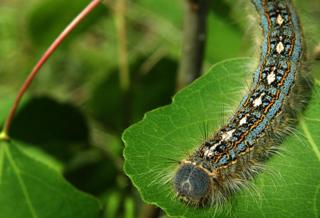Mar 4 2015
In a high carbon dioxide world, the trees would come out ahead. Except for the munching bugs.
 A forest tent caterpillar rests on an aspen leaf. These caterpillars are found in hardwood forests throughout the United States, where they feed on the leaves of trees like aspen and birch. CREDIT: Photo courtesy of John Couture, UW-Madison
A forest tent caterpillar rests on an aspen leaf. These caterpillars are found in hardwood forests throughout the United States, where they feed on the leaves of trees like aspen and birch. CREDIT: Photo courtesy of John Couture, UW-Madison
A new study published today [Monday, March 2, 2015] in Nature Plants shows that hungry, plant-eating insects may limit the ability of forests to take up elevated levels of carbon dioxide in the atmosphere, reducing their capacity to slow human-driven climate change.
The finding is significant because climate change models typically fail to consider changes in the activities of insects in the ecosystem, says Richard Lindroth, a professor of ecology at the University of Wisconsin-Madison and the leader of the study. The research suggests it's time to add insects to the models.
Carbon dioxide typically makes plants grow faster and makes them more efficient in how they use nutrients. But the amount of damage caused by leaf-munching bugs in the study nearly doubled under high carbon dioxide conditions, leading to an estimated 70g of carbon-sequestering biomass lost per meter squared per year.
"This is the first time, at this scale, that insects have been shown to compromise the ability of forests to take up carbon dioxide," Lindroth says.
In addition, as feeding increased, more nutrients moved from the canopy to the forest floor in the form of insect fecal material and chewed-on leaf scraps, mixing into the soil and likely altering the nutrient profile of the forest.
"Insects are munching on leaves and they're pooping out remnants, so they are changing the timing of nutrient cycling as well as the quality," Lindroth says.
John Couture, a former graduate student in Lindroth's lab and the lead author of the study, spent three years with his team studying the impact of elevated carbon dioxide alone, elevated ozone (which is highly toxic to plants) alone, and elevated levels of both gases combined on stands of aspen and birch growing in what was once one of the largest simulated ecosystems in the world, the Aspen Free-Air Carbon dioxide and ozone Enrichment (Aspen FACE) experiment located near Rhinelander, Wisconsin.
Unlike a greenhouse or atmospheric chamber, the FACE site (now decommissioned) was a massive outdoor experimental area that allowed trees to grow under natural conditions, like natural soil, sunlight, and rainfall. The only artificial conditions were those that were experimentally manipulated.
The site consisted of a dozen stands of trees growing in 30 meter diameter plots, surrounded by a network of PVC pipes designed to vent gases into the environment around them.
They were exposed to carbon dioxide and ozone at levels predicted for the year 2050, although Lindroth says the 560 parts-per-million carbon dioxide level studied is probably too low.
The trees were planted as saplings in the mid-1990s and by the time Couture collected data for the study from 2006 though 2008, they had grown to resemble any number of the disturbed forest stands found throughout Wisconsin.
Couture and his team walked through each site, clipping leaves from the canopy using scissors at the end of pruner poles or from scaffolding near the top of the canopy. They also set out frass baskets -- laundry baskets lined with sheets -- to collect scraps of leaves dropped by messy, munching caterpillars and other bugs dining in the canopy, and to collect their fecal droppings.
Tens of thousands of leaves and countless frass baskets later, Couture measured the amount of leaf area consumed by the insects in each plot and sifted through the frass and food droppings in the baskets to assess just how much eating the bugs were doing, to measure the amount of nutrients leaving the trees via their droppings, and to assess the loss of tree biomass.
Why insects would do more munching in a carbon dioxide rich forest is in part a matter of chemistry. Because carbon dioxide is a limiting resource for plant growth, high levels of the gas change the way trees use other resources, like nitrogen, typically leading to less nutritious plants.
"It's like a slice of Wonder Bread versus a slice of high density, protein-rich bakery bread; there's a lot more protein in the bakery bread than the white bread," says Couture. "Insects have a base level of nutrients they need in order to grow and to reach that, they can choose either to eat higher-nutrient food -- unfortunately, insects don't always have that choice -- or to eat more."
Overall, the team found high ozone plots were less hospitable to insects, reducing their munching behavior and leading to less biomass loss.
With the findings, the researchers created models allowing them to predict what could happen in forests under changing environmental conditions.
"The big question is, will northern forests grow faster under elevated carbon dioxide?" says Lindroth. "Carbon dioxide is a substrate for photosynthesis. It gets converted into sugars, which then become plant biomass. Will trees take up more carbon dioxide and thus help reduce its increase in the atmosphere?"
As humans continue to contribute more carbon dioxide to Earth's atmosphere, the answer should be yes as trees act as sponges for the greenhouse gas. But it turns out, very hungry caterpillars and their bug brethren -- in their own quest for food in an elevated carbon dioxide environment -- may limit that growth and reduce the capacity of forests to slow climate warming.